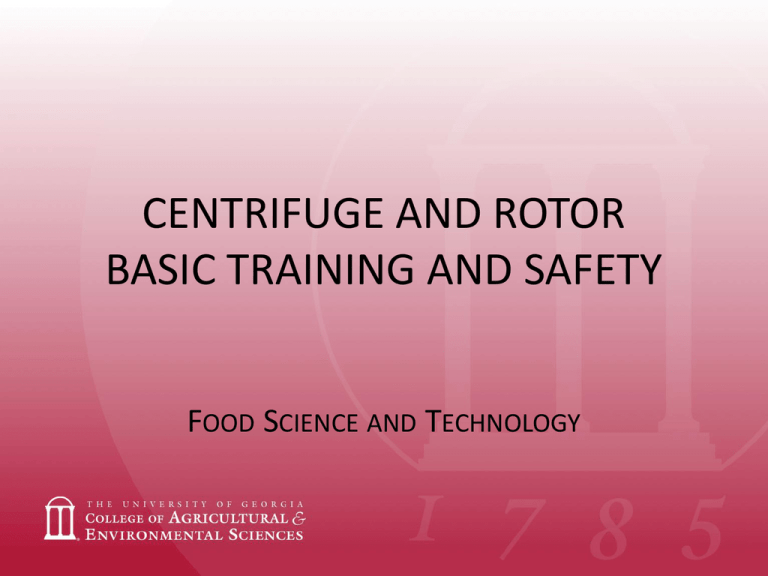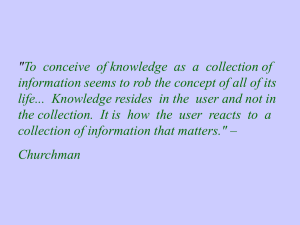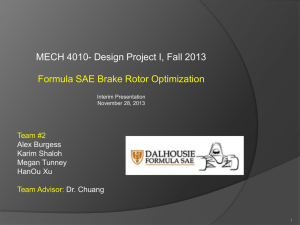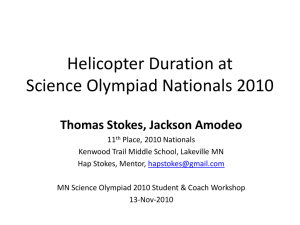Centrifuge and Rotor Basic Training
advertisement

CENTRIFUGE AND ROTOR BASIC TRAINING AND SAFETY FOOD SCIENCE AND TECHNOLOGY IN CASE OF EMERGENCY DIAL 911 OR CALL CAMPUS POLICE TO CALL: FROM REGULAR OR CELL PHONES: FROM CAMPUS PHONE: UGA Police 706-542-2200 2-2200 Athens-Clarke County 911 911 Direct line for hearing impaired (TTY) 706-542-1188 2-1188 Technical Support Contacts (TSC): Vickie Wentzel vwentzel@uga.edu Danny Morris dmorris@uga.edu Before Using a Centrifuge Safety First!!!! Safety, Safety and Safety Never run the centrifuge without training and self confidence • If uncertain, please request assistance In order to use the Centrifuge you must: • Be a member of the Food Science Department • Study all training materials • Receive operating and safety instruction from a designated instructor • Have your signature on file agreeing to comply to all manufacturer and Food Science operating guidelines The Sorvall RC6 Plus centrifuge located in room 304 of the Food Science building is a department instrument. No one outside of the department is allowed to use it without special permission. Contact vwentzel@uga.edu for permissions Centrifuge Failures And Accidents REALLY Do Happen The importance of keeping a usage log cannot be over-emphasized. This log determines when a centrifuge rotor should be removed and replaced with a new one. Cornell University: “A campus laboratory was seriously damaged when the rotor of an ultracentrifuge failed while in use. Flying metal fragments damaged walls, the ceiling, and other equipment. The shock wave blew out the laboratory's windows and shook down shelves.” “A centrifuge failed at Carleton University, resulting in an implosion within the laboratory. Luckily, only minor injuries occurred.” Handling and the amount of mechanical stress that is placed on a centrifuge’s rotors results in corrosion of the rotor over time. Damaged and corroded rotors can easily result in a centrifuge explosion. • Do not use rotor’s beyond their scheduled Safety Guidelines: • The rotors of the centrifuge need to be life span constantly inspected for damage or signs of • Properly load and balance the centrifuge • Maintain the usage log: corrosion • include the type of rotor used • Select the proper rotor • the speed of the operation • the length of time the rotor was used What is RPM, RCF and G RCF stands for “Relative Centrifugal Force” and is measured in force x gravity. This is the force exerted on the contents of the rotor (also noted as g-force or G) resulting from the revolutions of the rotor. It is RCF, not RPM that separates solutions in the centrifuge. G-force is limited by sample size and rotor. G-force is the determining factor when setting speed, not RPM. Never exceed or operate the centrifuge at max speed or g-force. RPM stands for "Revolutions Per Minute." This is how centrifuge manufacturers generally describe how fast the centrifuge is going. The rotor, regardless of its size, is revolving at that rate. The force applied to the contents varies by the size of the centrifuge rotor. The force exerted on a particle in a centrifuge is a simple function of the rotation speed of the centrifuge and the radius of rotation. The actual equation is: RCF or G-force= 1.12 x R x (RPM/1000)² R is the radius of rotation measured in millimeters. For example in the photograph R is 240mm. R can be measured at the top of the tube (Rmin), the middle of the tube (Rav) or the bottom of the tube (Rmax). Thermo Scientific Sorvall™ RC 6 Plus Centrifuge Food Science & Technology Rm. 304 Main Parts We Handle CHAMBER ORINGS & VACUUM GREASE ROTOR & LID SAMPLE BOTTLES & TUBES FST Rotor Inventory & Selection NOTE: THE SLC-1500 LID WAS FACTORY REPLACED W/ F14S LID . SORVALL RC6+ WILL AUTO RECOGNIZE THE ROTOR AS SLC-1500. Rotor Precautions • Ensure that the rotor and lid are clean and show no signs of corrosion or cracking. • Ensure that the metal threads in the rotor are clean and lightly, but evenly, lubricated with silicone vacuum grease. • Ensure that O-rings are present and clean, in place and lightly, but evenly, coated with silicone vacuum grease. • Ensure that the rotor pins are not sitting ON the spindle pins. Attach rotor and check for movement. ! HANDLE rotors carefully; place rotors on clean soft surfaces only. NEVER sit or slide rotors on benches or any other surface. Take care to not hit the rotor against hard surfaces, especially the centrifuge spindle. ! NEVER run a rotor with a missing O-ring, the sample contents may be lost, leading to rotor imbalance, failure, and serious damage to the ultracentrifuge . ! Do not glob vacuum grease, apply a very fine/light coating to the threads and O-rings, if necessary. Selection of Centrifuge Bottles or Tubes Consider the following, when choosing or using sample bottles or tubes: • Rotor specifications for tube style, i.e., conical, round or flat bottom. • Sample compatibility with tube materials. • Volume of sample. • Maximum allowable compartment mass. • Relative speed required (g-force). • Protocols to be used for loading and sample recovery . ALWAYS, examine tubes for signs of stress and discard tubes that look suspicious (i.e., discoloration, crazing, spots that do not come off, scratches, cracks, etc.). Filling and Balancing Bottles or Tubes • A ”balance” bottle, tube, etc must always be located opposite the sample tube. The balance tube may be sample or a suitable liquid. • Opposing bottles, tubes, lids, and samples in rotor must be balanced using a digital balance. Balance tubes that will be opposite each other in the rotor to within at least 0.1 g. Visual estimates are not accurate and are hazardous to centrifuge use! • Opposing tubes must be the same mass, but can be different masses from other opposing tube pairs. • Each rotor has a maximum allowable compartment mass. The total contents of any compartment, including specimen, tubes, sealing assembly and adapters must not exceed the specified maximum compartment mass unless rotor speed is reduced proportionately. Prolong Tube Life and Avoid Breakage or Collapse • Autoclave tubes only if absolutely necessary and only at 121°C for 15 min. • Avoid cleaning plastic tubes in automated dishwashers or glassware washers, which may produce excessively hot temperatures. • Clean tubes with a mild laboratory detergent in warm water, rinse, and air dry. • Tubes must be carefully matched with rotor type to prevent sample loss and/or failure as illustrated. Did not use proper tubes which caused tubes to collapse inside the rotor resulting in samples loss Damage to a JLA10.5 Rotor Resulting damage to a Beckman JLA 10.5 rotor which occurred due to the persistent use of aged and deficient polypropylene 500 ml sample bottles. There was a lack of awareness and precaution by the operator who should have been more knowledgeable and concerned about the condition of the bottles which were used. Centrifuge repair: $10,035.25 Rotor replacement: $8,910 FST Centrifuge Damages 2014 Rotor was not positioned properly onto the centrifuge spindle; pins under rotor were setting on top of the spindle pins which ground down the pins on both the rotor and the spindle Cost of repair: $2763.20 Spindle failure and poor handling, i.e., scratches damaged 2 rotors. Cost of Repair: $4029.47 2 failed rotors used in the RC6+ centrifuge resulted in spindle failure Cost of Repair: $2248.00 GRAND TOTAL: $9040.67 Down time: ~ 2 months These damages could have been avoided by following FST and manufacturer guidelines IF YOU HAVE QUESTIONS ASK! Rotor Prices April, 2014 F10-6x500y Rotor $11,615.63 SLC-1500 equivalent $8,832.38 F21-8x50 $6,030.00 F13S-14X50ML $7,441.00 Pre-Run Check Ensure centrifuge inner walls, spindle and rotor/rotor cavities are dry and clean ‒ Wipe spindle threads and apply a fine film of lubricant grease to the threads. Be sure the rotor is appropriate for the instrument ‒ Refer to the FST Rotor Inventory . Inspect the rotor ‒ Ensure rotor is clean and dry, check for rough spots, pitting, damage and discoloration, if discovered notify TSC. ‒ Wipe threads and apply a fine film of lubricant grease to the thread portion of the rotor cover and rotor cover knob. Make sure the lid and rotor are matched ‒ Rotor number is engraved on the lid. Ensure rotor is properly seated on drive hub ‒ DO NOT HIT THE SPINDLE OR DROP THE ROTOR ONTO THE SPINDLE, sensors and parts to this spindle are very expensive. Examine sample tubes for signs of stress and discard tubes that look suspicious ‒ Do not reuse disposable tubes. ‒ Avoid overfilling of tubes and bottles (consider maximum compartment mass). ‒ Make sure tubes are properly balanced in rotor. Operation Instructions Turn on centrifuge—flip switch on front panel to “ON” position Place balanced samples into rotor Attach rotor lid • Turn lid counterclockwise to secure. • Check to be sure that cover is on tightly by ensuring that there are no gaps. between lid and rotor, pull up lightly on lid to make sure that it is securely attached. • Lid should be secure, but do not over tighten. Carefully load rotor onto spindle Secure rotor to spindle by turning the center rotor locking knob counterclockwise • Rotor should sit flat on spindle, it should not rock back and forth. • Pull upward lightly from base of rotor to be sure rotor is secure, there should be no movement along spindle if rotor is properly attached. Close the chamber door Operating Instructions Set run parameters from the RUN SCREEN • The RUN SCREEN shows the set and actual run conditions • The speed (SPEED), time (TIME) and temperature (TEMP) displays have a two-line display • The upper line shows the actual run state • The lower line shows the set value • The acceleration (ACCEL) and deceleration (DECEL) displays show the set value A blinking cursor allows entry of numeric values (a cursor appears and blinks on the entry line of a run condition display by pressing a cursor key) • Press a cursor to initiate enter mode • Move the cursor to the desired item by pressing the cursor keys (continued) Operating Instructions (continued) Select the rotor that will be used Set speed: • Choose which speed (rpm) to set to achieve desired g’s • (g ≠ rpm) • Enter the desired value with the ten-key numerical pad • Check the setting and fix it by pressing the ENTER key • The CE key is used to cancel the setting Estimation of g forces when using different rotors is not a trivial task If ever unsure of g force calculations, ask a TSC NOTE: If your method reports a ‘g’ force, you can use another rotor to achieve the same g force ! If your method reports an ‘rpm’ without information on the type of rotor, you do not have all the information you need Set temperature • If using sub ambient temperatures, allow rotor to equilibrate (cool) ~20 min while in the centrifuge before starting Operating Instructions Set run time Press Start • Make Sure The Run Is Proceeding Normally Before You Leave The Area • A little vibration is normal, but excessive amounts can mean danger. If you see the centrifuge wobbling or shaking, Hit STOP, Leave The Area Immediately And Notify An FST Emergency Contact Person. After the run remove rotor, samples, check for leaks and turn off centrifuge • Wait until “door” light is on to open door • Turn the center knob in the appropriate direction to release the rotor from the spindle Fill out the centrifuge and rotor log and proceed with cleanup • Record length of time, rotor used, and rotor speed in log on bench across from centrifuge. • Record the actual spin time, do not include equilibration time Persons that do not log usage will be banned from centrifuge use • Clean any spills, rotor and centrifuge Operating Procedures - Summary PRE-RUN • Turn on the centrifuge • Enter set up parameters: • rotor, speed, time, temperature, accelerate and decelerate speed (8) • Load balanced samples into the rotor • Secure the lid to the rotor • Open the centrifuge door • Load the rotor, with O-ring • Make sure the rotor is properly seated on the drive hub • Secure the rotor with center knob, close the centrifuge door • Press ENTER then RUN/START • Wait for centrifuge to achieve set speed before leaving POST-RUN • After the centrifuge has completely stopped, open the door, remove sample bottles or tubes, take out the rotor • Never leave rotor inside the centrifuge • Turn off the centrifuge • Clean and dry centrifuge and rotor • Return rotor to cabinet • Fill out the user log • Leave the centrifuge door open SOP for Cleaning Rotor • Wash rotors and rotor components immediately if salts or other corrosive materials are used or if spillage has occurred Don’t allow corrosive materials to dry on the rotors • Use plastic or wooden tools to carefully remove O-rings or gaskets for cleaning • Use a mild detergent diluted 10 to 1 with water, and a soft brush to wash rotors and rotor components and accessories never use an ordinary bottle brush with sharp wire ends that could scratch anodized surfaces • Rinse thoroughly with DI water; DO NOT IMMERSE ROTOR IN WATER • Do not soak in detergent solution for long periods, such as overnight • Don’t wash rotor components or accessories in a dishwasher • Air-dry the body or buckets upside down. DO NOT USE ACETONE TO DRY ROTORS





